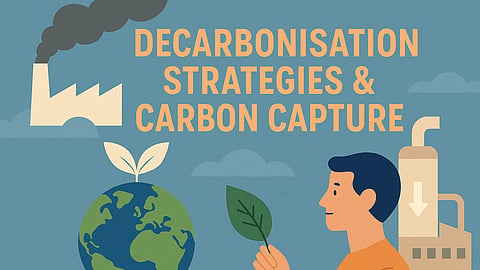Decarbonisation: A Strategic Path to Climate Stability
Reducing emissions across all sectors—not just energy—is essential to limiting global warming. As the United Nations' IPCC has warned, greenhouse gas emissions must peak before 2025 and decline by 43 % by 2030 to stay within the 1.5 °C threshold.
Achieving this demands integrated decarbonisation: shifting to renewables, electrifying transport, pursuing green hydrogen, and deploying carbon capture across hard‑to‑abate industries like steel, cement, and chemicals.
Carbon Capture: An Essential Climate Tool
Deploying CCUS Across Industries
Carbon Capture, Utilization, and Storage (CCUS) offers a way to curtail unavoidable emissions—especially in industries that cannot easily decarbonise for technical reasons.
According to the IPCC, nearly all pathways that keep warming below 1.5 °C rely on capturing and storing up to hundreds of gigatonnes of CO₂ between now and 2100. Models show that even with high renewables uptake, industrial emissions still require CCUS to achieve deep decarbonisation.
Scaling Through Policy & Innovation
The Carbon Capture Coalition’s 2025 policy blueprint emphasizes accelerating deployment through incentives, permitting reform, expanded markets, and investment in next‑generation technologies. Jessie Stolark, Executive Director, stated: “These recommendations … will spur continued deployment of carbon management technologies to reach commercial scale in the next decade."
Wood Mackenzie analysts suggest a carbon price around US $150 per tonne by 2040 would underpin mass deployment—but such regimes remain distant.
In Norway, industrial-scale CCS is now operating at a national level—one of the world’s largest deployments—to reduce emissions while maintaining energy exports.
Innovations & Case Studies: Seabound’s Maritime Carbon Capture
A vivid example of carbon capture innovation comes from shipping: startup Seabound has developed modular containers filled with quicklime pellets that scrub carbon and sulfur directly from ship exhaust. In trials, these units removed up to 78 % of CO₂ and 90 % of sulfur emissions.
CEO Alisha Fredriksson explains her ambition: “It all happened really quickly. Suddenly we had money … I think people were ready for a solution.”
While quicklime production can itself emit CO₂, efforts are underway to produce “green quicklime”, using renewable energy or CO₂ capture during manufacturing.
Her vision: “We’re on hundreds to, hopefully, thousands of ships … we’ve got hubs in all the major ports around the world.”
Voices of Leadership & Climate Advocacy
Andrew Forrest, founder of Fortescue Metals Group, has become a rare example of aggressive climate action in the mining sector. With a US $6 billion decarbonisation plan aiming for “real zero” by 2030, he states: “Early adoption of green technologies will yield long‑term economic benefits."
Despite leadership changes—particularly the departure of Fortescue’s head of decarbonisation—its CEO Dino Otranto asserts that sustainability remains embedded in operations, including solar farms and electric mining equipment.
Meanwhile, Mark Carney, UN Special Envoy on Climate Action and Finance, backs carbon pricing and industrial decarbonisation solutions. He emphasizes that oil‑based sectors must clean up—not just individuals changing lifestyles—and sees CCS projects in Canada as vital to making carbon‑intensive industries viable while meeting national climate commitments.
Why These Strategies Matter
Accelerate Emissions Reductions: Decarbonisation paired with CCUS accelerates climate impact while enabling continued industrial output.
Support Zero‑Carbon Goals: Meeting 2030 and 2050 net‑zero targets without CCS is virtually impossible in many scenarios.
Stimulate Economic Growth: New projects across CCUS value chains promise jobs, innovation, and investment—while protecting critical industries.
Enable Transitional Flexibility: Solutions like Seabound's technology allow existing systems to reduce emissions now, alongside longer‑term fuel or energy transitions.
Final Thoughts
Innovative decarbonisation strategies combined with scalable carbon capture offer one of the most promising routes to avoiding catastrophic global warming.
As high‑profile leaders declare and implement ambitious plans—from real zero mining operations to modular ship‑mounted CO₂ scrubbers—the message is clear: saving the environment requires deploying clean energy, electrification, deep industrial transformation—and crucially, capturing carbon where emissions can’t be eliminated outright.
By supporting bold policy, financing, and innovation in CCUS, governments and industry leaders can chart a path towards a safer, sustainable, and prosperity‑driven global future.


